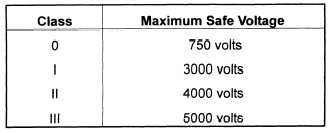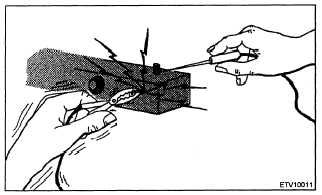Table 3-2.—Rubber Gloves
pair of electrical safety rubber gloves rated for the
appropriate voltage (see table 3-2).
5. Have a co-worker stand by; don’t work alone.
Make sure your co-worker knows where to secure the
power in case of emergency.
Follow these four safety precautions whenever you
take measurements on energized equipment:
1. Always use test probes with safety guards or
barriers on the probe tips. This will prevent your hand
from in advertently touching the probe tip.
2. Always used insulated alligator clips.
3. Always keep your body clear of any metal parts
of the equipment on which you’re working.
4. Try and keep one hand in your pocket or behind
your back when taking the measurement. This will
prevent you from creating a ground path for electric
current flow through your body from hand to hand.
Here is an excerpt from a mishap report that will
show the importance of following the above
precautions:
Member could not get alligator clip on test
lead to stay on probe so he held clip to probe with
right hand. Member violated safety precautions
by continuing to hold clip and probe while
energizing the test lead with 1200 volts. Soon
thereafter, the member touched the ground lead
and received serious shock. The member was
treated for minor burns on the palm.
MEASURING VOLTAGE ABOVE
300 VOLTS
All the safety procedures for measuring voltages
below 300 volts apply when you are measuring voltages
above 300 volts. But, the big difference when
measuring voltages above 300 volts is that you must
NOT hold the test probe in your hand while the
equipment is energized. Instead, you’ll attach the test
probes while the equipment is de-energized. Here are
the safety procedures you should follow:
1 .
2 .
3 .
4 .
5 .
6 .
7 .
8 .
9 .
Follow all the preliminary safety procedures for
measuring voltage below 300 volts before
beginning your measurements.
Make sure the equipment you are working on is
DE-ENERGIZED. Follow the required tag-out
procedures.
With a shorting probe, discharge all high-
voltage capacitors.
Attach the ground probe of the measuring
device first.
Secure the other probe of the measuring device
to the test point to be measured.
Make sure the measuring device is setup for the
voltage level and polarity to be measured.
Energize the equipment under test, make the
measurement, and then de-energize the
equipment.
Discharge all high-voltage capacitors.
Remove the probes from the equipment.
ELECTROSTATIC DISCHARGE
PRECAUTIONS
Electrostatic discharge (ESD) can destroy or
damage many electronic components including
integrated circuits (ICs) and discrete semiconductor
devices. Certain devices are more susceptible to ESD
damage than others. Because of this, warning symbols
are now used to identify ESD-sensitive (ESDS) items
(fig. 3–1).
Certified 2M technicians are trained in procedures
for reducing the causes of ESD damage. The procedures
are similar for all levels of maintenance. Some of the
protective measures you should follow to prevent ESD
damage are:
Ground the work benches where ESDS devices
will be handled.
3 -4




